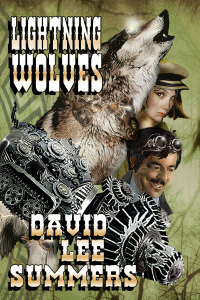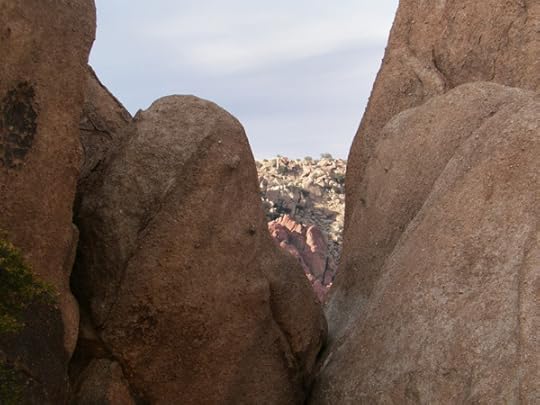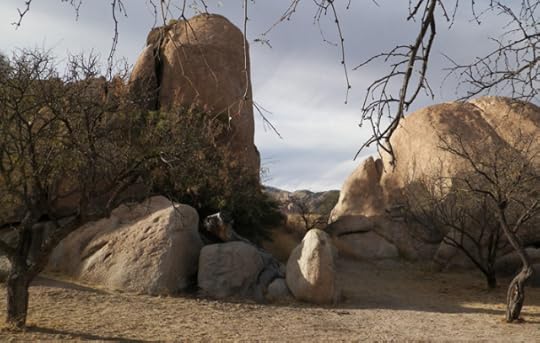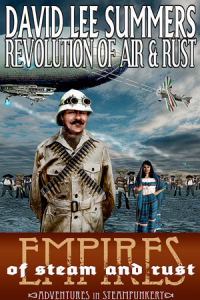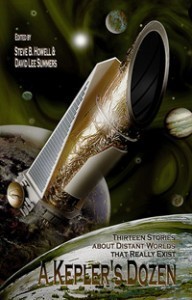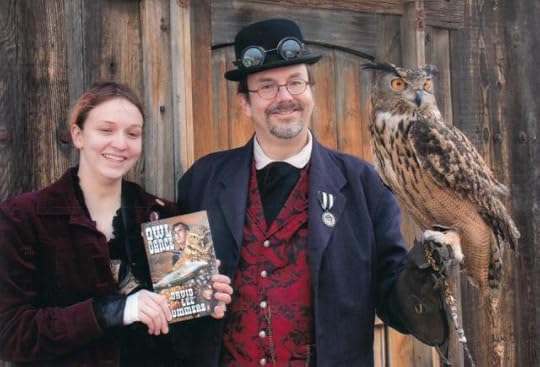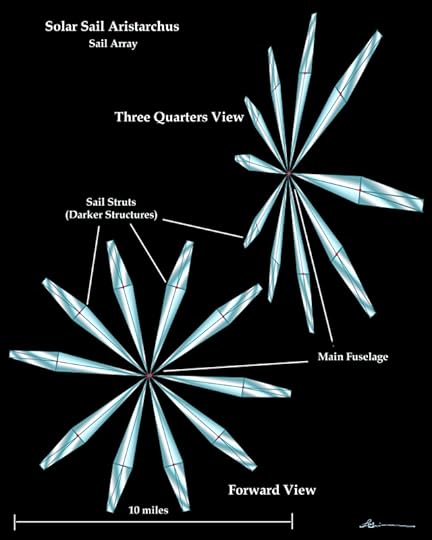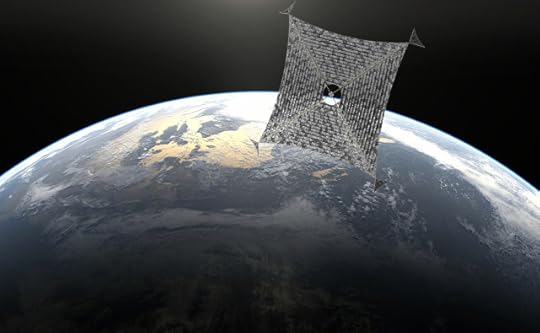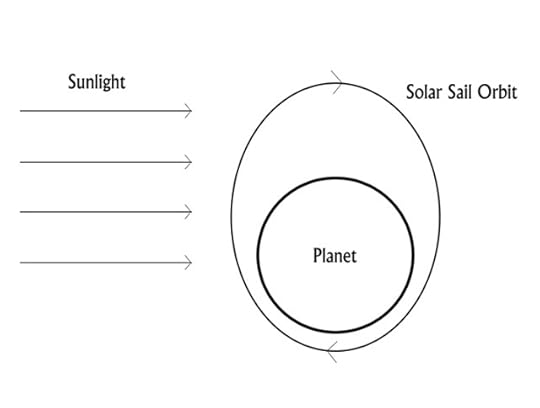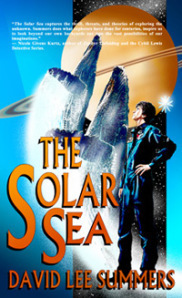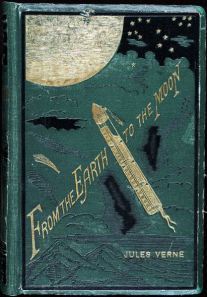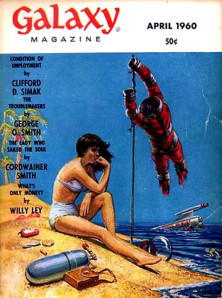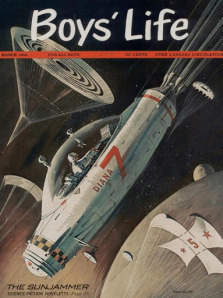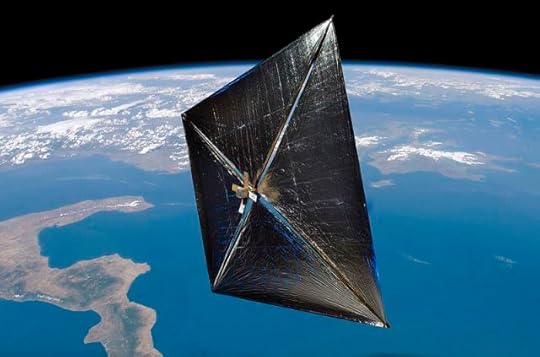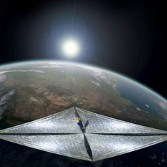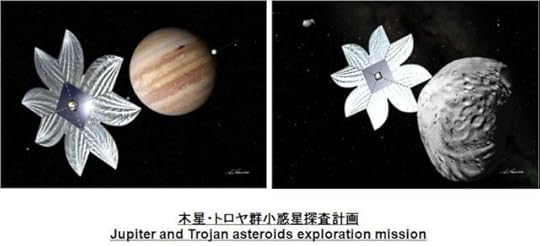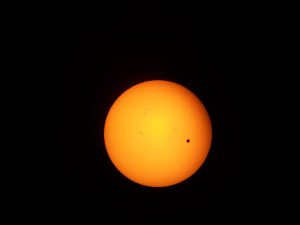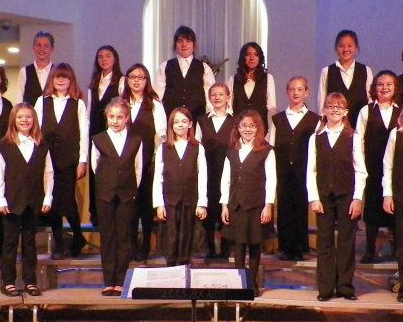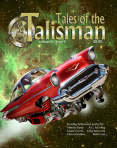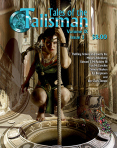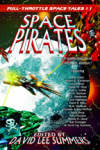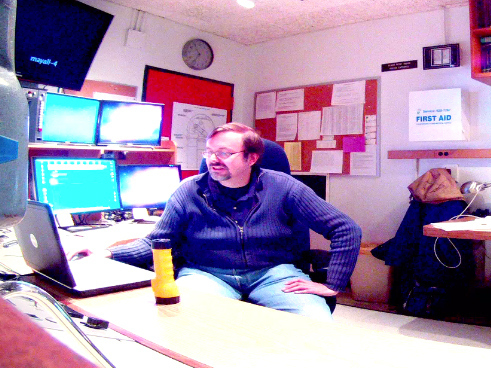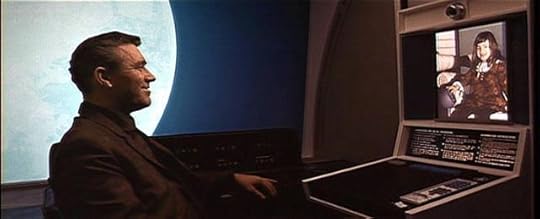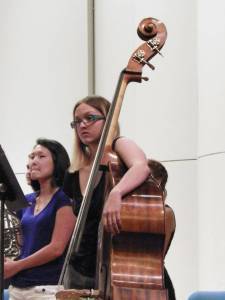David Lee Summers's Blog, page 111
March 8, 2014
The Dragoon Mountains
Today I’m at Wild Wild West Con at Old Tucson Studios, just outside Tucson, Arizona. If you’re in the area, I hope you’ll drop by. This is a fun convention! Aside from getting ready for the convention this past week, I’ve been hard at work revising my wild west steampunk adventure novel Lightning Wolves based on my editor’s notes. The new revision is almost finished and about ready to turn in. In some cases I’ve slapped my head when my editor pointed out something I forgot. In other cases, I’ve grumbled and complained to myself, made a revision, and grudgingly admitted I liked it better. No matter what, though, I have learned a lot from my editor on this book and I’m grateful for her thorough job.
Part of the action in Lightning Wolves is set in the Dragoon Mountains of Southern Arizona. As it turns out, I drive through the Dragoons just about every week on my commute to and from work. A little over a week ago, I took some time and wandered through the area, reminding myself of some of the settings from the novel.
The Dragoons are very dramatic and rocky mountains. They were also the source of real-life wild west drama. The Apache Warrior Cochise defeated a company of Confederate dragoons there in 1862 and stole their cattle. Hence the name of the mountains. The Confederates and the Apaches clashed again just a few days later and the soldiers reclaimed their livestock. Twenty years later, during Wyatt Earp’s famous Vendetta Ride, Earp’s posse captured and killed “Indian Charlie” Cruz in the Dragoons.
Lightning Wolves is set between these two historical events. In the novel, many of the soldiers who would normally have been in the area have been called to fight a Russian invasion in the Pacific Northwest and the Apache Warrior Geronimo has set up a stronghold in the Dragoons. Needless to say, this makes some of the remaining settlers, such as Newman Clanton and his sons very nervous. In the middle of all this is exiled Mexican inventor M.K. Maravilla and the bounty hunter Larissa Crimson, who appear on the book’s cover. What happens makes the Gunfight at OK Corral look like a petty squabble. I really am looking forward to sharing this novel with you!


March 4, 2014
Read an Ebook Week
This week, Smashwords is hosting its annual Read an Ebook Week promotion. Two of my books are available for fifty percent off as part of the event.
Revolution of Air and Rust is set during an alternate 1915, where Teddy Roosevelt is building an empire and only Pancho Villa stands in his way. The American Expeditionary Force under the command of General “Black Jack” Pershing has invaded Northern Mexico. Pancho Villa leads his revolutionary army in a desperate raid against the American force only to be outflanked. Just as Pershing’s airships prepare to deliver the death blow, Pancho Villa is transported to a parallel Earth where he finds an unexpected ally and the technology that might just turn defeat into victory.
Revolution of Air and Rust is a stand-alone novella set in the Empires of Steam and Rust world created by Robert E. Vardeman and Stephen D. Sullivan. A story filled with military action, espionage and gadgetry that’s sure to satisfy fans of steampunk and alternate history. The book is available for half off until March 8 at http://www.smashwords.com/books/view/254622. Remember to use the code REW50 on checkout.
A Kepler’s Dozen is an anthology of action-packed, mysterious, and humorous stories all based on real planets discovered by the NASA Kepler mission. Steve B. Howell, project scientist for the Kepler mission, and I both co-edited the anthology and contributed stories. Whether on a prison colony, in a fast escape from the authorities, or encircling a binary star, thirteen exoplanet stories written by authors such as Mike Brotherton, Laura Givens, and J Alan Erwine will amuse, frighten, and intrigue you while you share fantasy adventures among Kepler’s real-life planets. The book is available for half off until March 8 at: http://www.smashwords.com/books/view/325583. Again, remember to use the discount code REW50 to take advantage of the sale!


March 1, 2014
Wild Wild West Con 3
Only one week to go before Wild Wild West Con 3, which is held at Old Tucson Studios, outside of Tucson, Arizona. This is a great steampunk convention held at the location where many classic films and TV series were filmed, including the two Wild Wild West TV movies from the 1970s.
This year, Wild Wild West Con features concerts by Steam Powered Giraffe, The Nathaniel Johnstone Band, The Cog is Dead, and Professor Elemental. Dyno Staats will be performing his magic and there will be lots of panels and workshops. You can get all the info at: wwwc3c.oom
My schedule is as follows:
Friday, March 7
1pm at the Sheriff’s Office – Mars: A Land Across the Aether – A look at Victorian astronomers Percival Lowell and Nathaniel Green who did important work understanding Mars in the nineteenth century. Percival Lowell was the son of rich industrialists who owned an observatory in Arizona. In addition to being an astronomer, Nathaniel Green was a landscape painter and Queen Victoria’s tutor. Who had the most accurate vision of Mars?
Saturday, March 8
2pm at the Courtroom – Sparky and McTrowell’s Hot Potato School of Writing. Two teams will engage in a madcap writing event taking turns “writing” a story. It will be both instructional and fun, and has an emphasis on audience participation. Inspector Erasmus L. Drake and Dr. Sparky L. McTrowell have asked me to join them for this thrilling writing challenge. You should join us as well. It will be fun, or as Dyno Staats says, “Something could go horribly wrong!”
4pm at High Chaparral – Steampunk Authors – Steampunk and history writers Muffy Morrigan, David Grasse, and David Lee Summers gather to discuss the challenges of researching, writing, and creating. What works. What doesn’t work. Are there new challenges to getting your work published? How do you keep your steampunk writing fresh and topical? How do you find the topic for your next book?
Sunday, March 9
2pm at High Chaparral – Steampunk Magic and Science – Magician Dyno Staats and Astronomer David Lee Summers look at the worlds of Victorian era magic and science and explore the ways they advanced together.
When I’m not at these awesome events, you’ll find me over at the Stage-II Vendor Area where I’ll have an assortment of my Steampunk and Wild West books available. Come by say “Howdy!”


February 22, 2014
Steering Solar Sails
Deby Fredericks asked how to steer a solar sail. The short answer is you do so by turning the sails just like a sailboat. In some solar sail designs, the sails simply rotate on their masts. This was the design I went for in my novel, The Solar Sea. Below is an illustration of the solar sail Aristarchus from the novel by Laura Givens. Each of those sail petals can rotate on its mast 360 degrees. If they face the sun full on, they get the full benefit of light pressure. If you turn them 45 degrees, you’ll alter the course of the ship. If you turn them 90 degrees from the sunlight, you won’t get any acceleration.
Some solar sails like NASA’s forthcoming Sunjammer have little triangular extensions of the sails. Those are the parts that turn in that design. The idea is that induce a little roll to the craft, which allows the whole thing to turn.
Now, we can also look at the way a solar sail might accelerate out of an orbit. A good way to think about solar sailing is that it’s like sailing in water, but where gravity acts like a current and light pressure acts like wind. A body in orbit around a planet or other body is perpetually falling and an orbit is an ellipse.
In the case of a solar sail, if it turns its sails to face the sun when it’s at the top of the ellipse, it’ll get a little boost of acceleration away from the sun. Then if it turns its sails out of the sunlight as it comes around to the part of the orbit closest to the planet, it won’t slow down again. When it reaches the top of the orbit it can turn the sails toward the light again for another boost. In this way, each successive orbit gets a little higher and higher until your solar sail is where you want it, or it achieves escape velocity.
You can learn more about The Solar Sea at TheSolarSea.com. There you can see lots of Laura Givens’ cool concept art from the novel. For fans of The Pirates of Sufiro and its sequels, you can also get a look at the Rd’dyggians and the Titans. My novel The Solar Sea is available at:
Amazon.com
Barnes and Noble
OmniLit


February 15, 2014
Solar Sails in Science Fiction
As promising—and romantic—a technology as solar sails are, it’s perhaps not surprising that they have found their way into fiction numerous times. Perhaps the first mention of the idea of using light to propel a spacecraft is in Jules Verne’s 1865 novel From the Earth to the Moon. In Verne’s novel, a giant cannon is used to send a spacecraft to the moon. However, Verne writes that such a projectile has limited velocity. “Is it not evident, then, I ask you, that there will some day appear velocities far greater than these, of which light or electricity will probably be the mechanical agent?” asks Verne. The thing is, Jules Verne was right on top of the scientific achievements of his day. He knew that James Clerk Maxwell had recently discovered that light exerts a pressure on objects.
Compelling as this idea is, it seems that no one pursued it further until an engineer named Carl Wiley wrote an article for Astounding Science Fiction in 1951 about how solar sails could be built in orbit and used for space travel. The article was called “Clipper Ships in Space” and was written under the pseudonym Russell Saunders. This article influenced more than one science fiction writer. The first was Cordwainer Smith who published the story “The Lady Who Sailed The Soul” in Galaxy Magazine in 1960. The story was mostly about the romance of two characters, but it also does a fairly good job of describing a solar sail spaceship.
The next appearance of a solar sail in science fiction was in Pierre Boulle’s novel Planet of the Apes in 1963. To quote from the novel: “In those times, interplanetary travel was commonplace, though interstellar ventures were still an exception. Rocket ships would take the tourists to fabulous locations on Sirius or the finance people to the stock markets of Arcturus and Aldebaran. But Jinn and Phyllis, a wealthy and free couple, were known through the Cosmos to be young originals, with a bit of craziness, and they would cruise through the Universe just for the fun of it—with their sailcraft.” Boulle then goes on to describe the craft: “Their ship was a kind of sphere with a shell—the sail—made of amazingly thin material, and it would move through space, just pushed by the pressure of light beams.”
A year later, Arthur C. Clarke published the story “The Sunjammer” in Boy’s Life Magazine that told the story of seven solar sails racing from the Earth to the Moon. This story in particular captured many scientists’ imaginations and caused them to seriously ask the question of whether or not these kinds of craft could be developed. In fact, NASA’s first solar sail mission to deep space has been dubbed “Sunjammer” in Clarke’s honor. You can visit the project’s homepage at: sunjammermission.com
Light sails have continued to appear in science fiction since then. Notable appearances include the episode of Star Trek: Deep Space Nine called “Explorers” and Star Wars Episode II: Attack of the Clones. No doubt solar sails will continue to appear in science fiction. My own novel, The Solar Sea, about a solar sail spacecraft that’s used to explore the outer planets was published in 2009. You can read more about it at thesolarsea.com
Science and science fiction are closely intertwined with solar sails. In the middle of the nineteenth century, James Clerk Maxwell discovered that light exerted a pressure on objects. Soon after, Jules Verne posited that such a force could be used to move a spacecraft. In the 1950s an engineer published an article about light sails in a science fiction magazine and a few years later, science fiction writers were publishing stories about such craft. Now, scientists and engineers are working to turn the idea of solar sails into reality while science fiction writers continue to dream of sailing to distant planets and star systems.
Is there something about solar sails you’d like to know and I didn’t cover? Let me know in comments and I’ll see if I can find out for you and post next week. I’ve already been asked how to steer a solar sail. I’ll do my best to explain!
My novel The Solar Sea is available at:
Amazon.com
Barnes and Noble
OmniLit


February 8, 2014
Solar Sail Projects
Light pressure has been demonstrated as a force that can, indeed, move a spacecraft. Back in 1974, when Mariner 10 was running low on fuel, NASA utilized light pressure against its solar panels to adjust its trajectory. Although this was a limited demonstration, light sail technology holds sufficient promise that scientists around the world are trying to turn this science fictional idea into reality. Public and private teams in the United States, Japan, and Europe are all actively working on solar sail projects.
Although it’s not as heavily publicized as some projects, NASA has been on the forefront of light sail development. On November 19, 2010, they launched a solar sail “nanosatellite” called NanoSail-D. It was a 100-square-foot solar sail that was deployed from NASA’s FASTSAT Satellite on January 20, 2011. Four booms with sails deployed from a craft about the size of a lunchbox. The image above is an artist’s conception of the craft, but to learn more about NanoSail-D and to see photos of the sail during it’s 240-day voyage, visit: http://www.nasa.gov/mission_pages/smallsats/nanosaild.html
In the longer term, NASA is developing a somewhat larger prototype solar sail. This larger sail would have an area approximately 13,000 square feet with a payload of 110 pounds. This makes it about seven times larger than the largest solar sail ever deployed. While the NanoSail-D project was essentially a simple sheet of reflective material designed to test the concept of solar sailing, the larger solar sail would include four small steering sails to test maneuverability of the craft. Currently, this larger prototype sail is scheduled to launch on a Falcon 9 in 2015. You can read more about this mission at: http://www.nasa.gov/mission_pages/tdm/solarsail/solarsail_overview.html
Perhaps the most prominent private group working to build a solar sail is the Planetary Society. They’re a non-profit organization in the United States dedicated to the support of space exploration. They attempted to launch a solar sail called Cosmos 1 back in 2005. Unfortunately, it was lost when the launch vehicle it was aboard—a Volna rocket launched from a Russian submarine—exploded on the way to orbit. The original craft looked like an octagonal mirror. Eight triangular sails surrounded a central hub. Each sail was mounted to the hub by a rotating mast. By changing the angle of the sails, the craft’s course could be adjusted. The updated project is called LightSail-1 and appears to be a much simpler design as shown in the photo at the top of the paragraph. For more information, visit: http://www.planetary.org/explore/projects/lightsail-solar-sailing/
Interest in solar sail technology isn’t limited to the United States. In 2011, the Japan Aeronautic Exploration Agency or JAXA successfully deployed a small solar sail called IKAROS (for Interplanetary Kite-craft Accelerated by Radiation Of the Sun). The test successfully demonstrated both sail deployment and the ability of a craft to fly by photon pressure. Later this decade, they hope to launch a probe to Jupiter that will be propelled by solar sails. An artist’s conception is shown below. You can learn more about the IKAROS mission, and see a cool gif of the sail in flight at: http://www.jspec.jaxa.jp/e/activity/ikaros.html
The European Space Agency has also been working on a prototype solar sail, but there is little information at this point about when they might try a flight. They appear to have a near-term project using solar sail nanosatellites to help remove debris from Earth orbit.
As we move toward the middle of the 21st century’s second decade, we find ourselves searching for “green” technologies that utilize the resources we have available as wisely as possible. Solar sails appear to be a promising, green technology that would allow humans to explore space wisely. Indeed, it is the only propulsion technology within our reach that could conceivably propel a spacecraft to near the speed of light.
In the next installment, I’ll look at solar sails in science fiction. In the meantime, you can learn more about my novel, The Solar Sea, which is set aboard a solar sail spacecraft at TheSolarSea.com. The novel is available at:
Amazon.com
Barnes and Noble
OmniLit


February 1, 2014
Solar Sailing
In 2008, when my novel The Solar Sea was released, I gave a presentation about solar sails at several science fiction conventions. I summarized that information in an article called “Sailing the Winds of Space” which appeared in Strange Weird and Wonderful Magazine online. The issue no longer appears to be available and I thought it was worth updating some of the information. I’ll be presenting the article over the next three weeks here at the Web Journal. I hope you enjoy this look at solar sailing!

Pottery depicting masted ships.
Photo by Einsamer Schütze. License: CC BY-SA
Sailing is one of the oldest transportation technologies. The simple use of wind to propel a craft across the water goes back to at least 3500 BC when the first representation of a ship under sail appeared on an Egyptian vase. Scientists around the world have explored ways to adapt this ancient technology for use in space flight. Sail technology is a way to make space flight more cost effective. Not only that, it’s possible that ancient sailing technology could propel a craft to near the speed of light. Sails for spacecraft would utilize light instead of wind. Such a sail is known as a light sail—or a solar sail if the primary light source is the Sun. This simple but powerful technology has also been an inspiration to numerous science fiction writers over the last fifty years.
Photons—individual particles of light—have momentum. When something with momentum strikes another object, it imparts some of its momentum to that object. Think of what happens when you play pool and the cue ball strikes another ball. The cue ball bounces off and the other ball moves in some direction. If you shine light at a mirror, the light bounces off, but it also imparts some momentum to the mirror. The reason you don’t see mirrors moving every time you shine light on them is that here on Earth, air pressure and gravity overwhelm light pressure. Light pressure from the Sun at Earth only produces about two pounds of force for every square kilometer. However, in space, where gravity is significantly less than it is on the ground and air pressure is no longer a factor, even a gentle force such as light pressure becomes significant.

Photo by No-w-ay in collaboration with H. Caps. License: CC BY-SA
Even though gravity and air pressure are no longer factors in space, solar sails must be built out of very lightweight material. Think about the billiard balls, but imagine replacing the cue ball with a marble. If you shoot a marble at a billiard ball, the marble will still impart momentum to the billiard ball, but it will take a lot more effort for the marble to move the billiard ball. By the same token, solar sails must be built out of the lightest possible material so that photon pressure will have the greatest effect when propelling the spacecraft. The materials currently being investigated for solar sails are somewhere between 40 and 100 times thinner than a piece of writing paper.
Fuel is one of the greatest costs in contemporary space flight and spacecraft must be designed to start their journey with all of the fuel they will need for the duration of the voyage. This is a significant engineering challenge. However, in the solar system, the sun produces an abundant, steady stream of photons that could be harnessed by a spacecraft. As such, light sails become a very attractive means of space propulsion.
Because light pressure is a very gentle force, solar sails would accelerate very slowly. However, as long as there is a supply of light, there is nothing that will stop the acceleration of a solar sail. Theoretically, a solar sail will continue to accelerate until it reaches the same speed as the particles striking it—the speed of light. According to Newton’s first law, an object in motion will remain in motion unless some force acts upon it. In space, where there is no friction, once a solar sail reaches the speed of light, it could continue at the speed of light. As such, light sails could theoretically be used for interstellar travel.
A common misconception is that solar sails are propelled by the solar wind. The solar wind is a stream of charged particles emitted from the sun. This stream of charged particles will transfer some momentum to any object it strikes, just as photons will. However, photon pressure from the sun is about 5000 times greater than the force from the solar wind.
In the next installment, I’ll discuss some actual solar sail projects.
My novel The Solar Sea, which imagines a voyage aboard a solar sail spacecraft, is available at:
Amazon.com
Barnes and Noble
OmniLit


January 25, 2014
Harmonizing
Two weeks ago I mentioned that my oldest daughter was performing in the New Mexico All-State Symphony Orchestra. Today, my youngest daughter is performing in the New Mexico All-State Choir here in Las Cruces. I’m looking forward to hearing her perform. She has been part of the Doña Ana Youth Choir for the last few years and I’m always amazed by the performances those kids deliver.
Much of this past week, I’ve been focused on Tales of the Talisman Magazine. We mailed out most copies of volume 9, issue 2—the autumn issue. I sent the winter issue—volume 9, issue 3—to press and copies have been ordered. They should be here within the week. Now, I’m busy reading stories for volume 10, issues 1 and 2. I’m pleased with my short list and I’ve sent out the first acceptances. Things are going well enough that I’m planning to wrap up the reading period in about a week on February 2. If you have a story or poem that you want to get in, this is the time to send it.
I find the process of selecting stories and poems for the magazine to be a little like gathering the voices of a choir. I look for a wide range of talent. I want stories and poems that both work well together and counterpoint each other. Every now and then, people take me very literally and decide to send me a story and a poem they wrote that they feel go together. Although that can be interesting, that’s not really what I’m looking for. I find it much more interesting when two authors who perhaps have never met send me things that address a common topic in different ways. I love it when that happens!
Of course, like any good choir, I want the final composition to be entertaining and satisfying. You can find the current issues of Tales of the Talisman at Amazon.com. The links for each issue are:
Volume 9, Issue 2
Volume 9, Issue 3
Arguably, themed anthologies are even more like a choir than a magazines are. The theme itself gives you that element that ties the stories together. When doing a themed anthology, I like to pick a theme that’s broad enough to allow a wide range of stories, while still being narrow enough to get different viewpoints on the same general topic.
As January draws to an end, we approach the final days that my anthologies in the Full-Throttle Space Tales series will be in print. The first editions of Space Pirates and Space Horrors go out of print on January 31. In the former anthology, I loved how the stories looked at pirates as both anti-heroes and villains. The horrors of the latter anthology took many different forms and we saw how they could pull people together and drive them apart. I’m planning to bring both of these anthologies back later this year, but if you want the originals, now’s the time to get them! Here are the Amazon links:
Space Pirates
Space Horrors


January 17, 2014
Parenting via Skype
Those who follow this journal know that I operate telescopes at Kitt Peak National Observatory. As “day” jobs for writers go, it’s pretty cool. This week alone, I’ve helped observe stellar clusters, galaxies, and quasi-stellar objects, and helped with the commissioning off a new spectrograph. However, this job can be challenging at a personal level. My typical shift involves six nights working from 4pm until sunrise plus occasionally one or two additional, partial nights. This time of year especially, that means I have just about enough time to go to a dorm room on the mountain and get six to seven hours of sleep before I have to do it all over again. As a parent, this means that for those days, the only interaction I get with my kids is via the VOIP program, Skype.
The photo shows me at a typical night at work. If all goes well, I’ll get a half hour in the afternoon or during the evening to catch up with my kids on the laptop and find out about their day. Because I work all night, the window to do this can be rather limited, sometime between the time they get home from afternoon activities and go to bed. If I have to wait until I’m at the telescope to call and talk, our time can be even more limited. This isn’t too bad if the kids don’t have much say, but more challenging if the kids have had a bad day. You can’t give a hug over the Skype line. Even if they have lots of good things to say, it’s painful to cut them off when the telescope needs my attention. There can be a lot of distractions if we are moving rapidly between targets or if problems crop up.
Unfortunately, the nature of operating telescopes is such that I can’t just go home at the end of the day. Even if I lived as close as possible to the telescope, I’d still have a two hour round trip each day, cutting the amount of sleep I’d get in the winter down to four or five hours. Another limitation I have is that I can’t use cell phones at the observatory, because they interfere with radio telescopes. Fortunately, tablets and laptops make VOIP capability almost as portable.
Thing is, I do consider myself rather lucky. There are lots of dads and moms deployed in the military who don’t get to communicate with their kids as often as I do and they certainly don’t get to see their kids in person every other week like I do. I’m very grateful for the sacrifices those brave men and women have to make in the service of the country.
I do have to admit to one cool factor about talking to my kids via Skype every day I’m at the observatory. I can’t help but remember the scene from 1969′s 2001: A Space Odyssey when Dr. Heywood Floyd talks to his daughter via video phone from a space station orbiting the Earth. The scene reminds me of my interaction with my kids here in 2014.
I’m grateful that technology allows me to work in this kind of job and allows me to interact with my kids almost every day. However, it can be stressful making those connections work some days I’m on the mountain. So, I do look forward to the days off when I not only have time to write books, I can spend time with my kids.
Don’t forget to visit my books page to learn about my novels and anthologies. I’m guessing there are some books you’ll enjoy. My oldest daughter is getting ready for college and telescope operators, like writers, probably don’t make as much as you think we do. I’m grateful to all of you who read my work.


January 10, 2014
A Collaborative Adventure
Today I’m in Albuquerque, getting ready to hear my daughter Myranda play bass in the New Mexico All-State Symphony Orchestra. She’s worked hard to be there. The last three years, she made the All-State Concert Orchestra. Making symphony is a step up in prestige for her and I’m proud she succeeded in this goal.
As a writer, I love symphonies. At the basic level, the music often inspires my writing, making me think of stories. At a deeper level, I think it’s fascinating to see how all of those instruments come together to make a piece of music. Hollywood director Nicholas Meyer once said, “The director is a bit analogous to the conductor of a symphony orchestra. It’s a collaborative adventure.”
Of course, writers often work alone, and the creation of a story or a novel doesn’t always feel very collaborative. However, at the fundamental level, a story is like a song and a novel is like a symphony. The writer uses the words like a composer uses notes. When the right words are used, its wonderful. When that doesn’t happen, the story or novel grates.
That simple analogy aside, I have to say my best experiences as a writer have come from genuine collaboration. They’ve come when I’ve worked with an editor to improve an outline or to make the words in a finished work shine.
I’ve also had great experiences working with artists illustrating my work. I know some writers who get very disappointed when an artist doesn’t interpret their writing exactly the way they imagined it. I actually find it fascinating when that happens. Sometimes it tells me I wasn’t as clear in my writing as I thought I was. Sometimes I see new things in my own writing that I had missed before. If I’m lucky enough to get the illustration before I’ve finished polishing a work, I’ve been known to go back and use elements from the illustration in the writing, making the process truly collaborative.
My only regret about being in Albuquerque this weekend is that it coincides with Her Royal Majesty’s Steampunk Symposium aboard the Queen Mary in Long Beach, California. I had an excellent time participating as a writer the last two years and I hope I’ll be able to return next year. If you’re in the area, I hope you’ll drop in. You’ll see the magic of Dyno Staats, hear music from such fabulous artists as Abney Park, Unwoman, and Lee Presson and the Nails, and much more. Clearly, though, it was important to celebrate my daughter’s accomplishment and I look forward to seeing many of my Southern California friends at San Diego’s Gaslight Gathering this spring!



